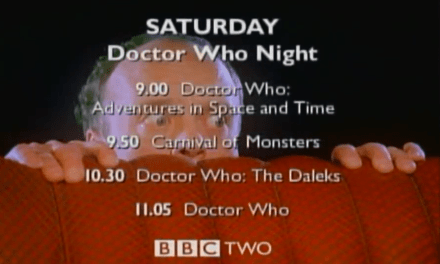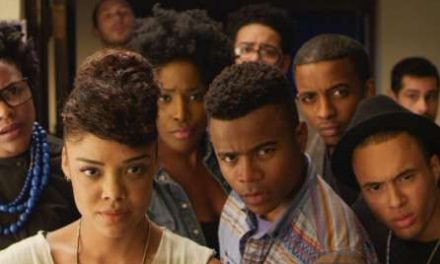During this time of Covid-19’s pandemic spread — when worries for ourselves and others can be all-consuming—we need jokes along with much else. I’ve (only partially) joked with my friends and family about my gratitude that at least we’re in the age of “peak TV”: for the many of us stuck at home, there is, thankfully, no dearth of television to watch. I find myself — as I’m sure so many others do — watching the full range of televisual offerings for hours on end: news and documentary specials to try to stay informed and prepared; comedy shows to lighten the mood, even if through wry commentary; TV series and serials to pass the time, self-soothe, and think through stories of other times, places, and people; films now, in a sense, “becoming TV,” as they go immediately to streaming services in the face of theater closures; and user-made televisual pieces as people around the world post their videos of their thoughts, dreams, performances, and pleas. Watching television can be a way to make isolation bearable, giving us a sense of contact and engagement from which we are now otherwise deprived, even as it also can become a kind of compulsion, as we keep staring at the screen in horror at what we’re seeing or in hopes of a glimmer of good news.
This movement between absorption and distraction, education and entertainment, involvement and distancing is, to borrow an epidemiological term, endemic to television, though that oscillation and blurring are certainly made much more visible in our current circumstances. Television has always been a site for both demarcating and crossing the categories of public and private, domestic and social, ordinary and strange, everyday and exceptional. As we both watch the outer world from our homes (at least those of us lucky enough to have them) and are invited into the lives of those we see on screen — lives, whether fictional or “real,” with which we are invited to identify as “like” our own ordinary existences, while they are also more exciting, more unusual, more worthy or in need of being televised — we are simultaneously brought together and kept apart. We are offered a screen that opens out seemingly to everything, even as this is all, precisely, screened and thus as obscuring as it is clarifying. (If this sounds dizzying, I would suggest that we can only understand the dizzying nature of our world today by thinking through its multiple, and often paradoxical, layers of screened mediation.)
Likewise, television both demarcates and blurs the boundaries between the familial, the communal, and the national: we are addressed as part of the TV family as we watch with our own (in whatever form), bringing us into a shared sphere of televisual references, knowledges, and familiarities — even “familial-ities” — that cross the country, to the point that watching television (particularly in times of national crisis, such as on 9/11) can be seen as almost patriotic. At the same time, given the transnational flow of images, television is also global (if still not quite global enough to make us as aware as we should be of other places, people, and perspectives). We are now all within the televisual universe — particularly during this period of transmedia convergence when we are able to access television (and, more broadly, an expanded televisuality) across a myriad of screens. In this way, TV and screen media both contain and connect, dividing us demographically, defining us by what we watch, keeping us in media bubbles, yet also helping us to feel a part of a community even when — or exactly as — we are physically separated.
In a sense then, televisual relations — simultaneously differentiating and dissolving the boundaries of self and other, individual and group — mirror and model our relations during the pandemic. Just as TV reaches the individual via communal appeals and vice-versa, creating wider audiences by hailing each specific viewer (e.g., networks call for us to tune in to find out “what we need to know” and “what you should do to stay safe”), so we are told to reach out — precisely by not literally, physically, reaching out — to our neighbors during this time of contagion. We must watch out for the community via each individual and, conversely, protect each individual via actions of the group, as seen in the advice that each one of us should act as if we are infected, increasing individual concern and mutual distancing so as to ease collective concern and create the conditions for mutual care.
The possibilities and pitfalls of television — its promises of communication and community along with its actual separations and hierarchies, not to mention its capitalist imperative in which profit trumps all other considerations — equally highlight the potential and perils we’re facing in society. TV can bring us together, but it also can yield tribal divisions; the image of Survivor‘s teams of “tribes” alarmingly comes to mind in thinking of some responses to the pandemic. With all that it could do to enable a global perspective, television can lead to nationalistic myopia and to intra-national partitions. This is clear in looking at media bubbles and the alarming production of “groupthinks.” Fox News, for example, was very slow to take the new Coronavirus seriously (with its opinion hosts long insisting that it was a manufactured hysteria designed to bring down Donald Trump), leading to greater disbelief of the facts of the pandemic and its spread to those viewers and to areas of the country in which they dominate.
 Trump himself — who, of course, reached fame through his reality TV show and uses television ratings as one of his primary, if not most valued of, metrics — has begun appearing on television daily, using the platform as a way to continue his campaign rallying once the actual rallies had to shut down in the light of the need (finally, after weeks of delay) asserted by his own administration for social distancing. In fact, these TV appearances are likely seen as even better than the rallies: just as he won the presidency by employing strategies from reality show competitions, Trump can here try to win over the public by turning to the conventions of TV drama (hospital shows with heroic doctors, procedurals in which one lays down the law so as to get order, and, of course, political dramas featuring in-command presidents, from The West Wing, 24, and Commander in Chief to Battlestar Galactica and Scandal). As Trump goes on and on about his great leadership (he can’t help himself from wandering away from the crucial matters at hand to boast that his briefing ratings are higher than those of The Bachelor), others in the frame sometimes seem like those captured in hostage videos (the most horrific form of televisual production). Having to compliment and thank the president before they can do anything else, they negotiate between the need to get approval from that audience of one and the desire to speak to the audience at large (an extreme dramatization of the individual/group oscillation noted above).
Trump himself — who, of course, reached fame through his reality TV show and uses television ratings as one of his primary, if not most valued of, metrics — has begun appearing on television daily, using the platform as a way to continue his campaign rallying once the actual rallies had to shut down in the light of the need (finally, after weeks of delay) asserted by his own administration for social distancing. In fact, these TV appearances are likely seen as even better than the rallies: just as he won the presidency by employing strategies from reality show competitions, Trump can here try to win over the public by turning to the conventions of TV drama (hospital shows with heroic doctors, procedurals in which one lays down the law so as to get order, and, of course, political dramas featuring in-command presidents, from The West Wing, 24, and Commander in Chief to Battlestar Galactica and Scandal). As Trump goes on and on about his great leadership (he can’t help himself from wandering away from the crucial matters at hand to boast that his briefing ratings are higher than those of The Bachelor), others in the frame sometimes seem like those captured in hostage videos (the most horrific form of televisual production). Having to compliment and thank the president before they can do anything else, they negotiate between the need to get approval from that audience of one and the desire to speak to the audience at large (an extreme dramatization of the individual/group oscillation noted above).
For all his complaints, Trump is no doubt the greatest purveyor of “fake news” (even if he is not the originator of the phenomenon or of the term, which he falsely claims to have coined), and, now more than ever, it is critical to fact-check his statements. All TV networks should refuse to carry these news conferences live (which make use of one of TV’s still best selling points: its capacity for liveness) and instead delay them until such fact-checking can appear simultaneously on screen. But, for good or for bad, fact and fiction have always been blurred on television: both tend to be treated through similar conventions and tropes (such as that of “the update” on “the situation,” keeping us aware both of news stories — which are stories — and of the latest hijinks of your favorite sit-com family). Whole genres are based on the pleasures and perils of confusing, as well as attempting to disambiguate, fantasy and reality in TV’s blur.
This blurring, of course, can yield troubling confusions, with a high potential for misinformation (or, in the worst of cases, purposeful disinformation for political ends). But it can also, in the best of cases, inspire imaginative resources and responses, creative problem solving, and productive ways of thinking, feeling, and working through difficult times. Indeed, for all of the absurd, sensationalist, apocalyptic predictions that some folks are making today — or, conversely, the absurd accusations that others, like serious journalists and scientists, are just conspiratorially hyping things up with purposely false apocalyptic predictions — we might actually learn something from some of the more thought-provoking dystopian and (post)apocalyptic TV shows that have been made. Think of Battlestar Galactica again, 12 Monkeys, Mr. Robot, iZombie, The Expanse, among many other series. At this point, such programs may jar us less than TV’s more “everyday” fare. Consider, for instance, how strange it already has become to see, on television productions shot months ago though just airing now, people casually touch, embrace, and sit close to one another without jumping apart to wash hands and wipe things down!
As our most “mainstream” media form, television itself helps to determine what we feel is strange or mundane, exceptional or expected, as it necessarily moves us between and balances these poles — capturing attention through its display of the unexpected, but making even the unexpected mundane through its very televisualization. It may thus help us think about those dynamics of the everyday and the exception — particularly at a time when we must, indeed, treat every day as an exception in order to provide more days ahead; just as we have to be alert to how the logic of “the exception” can be deployed for troubling political ends.
TV is producing a “new normal” for us in these strange times, and it can incite us to ask what new productions might emerge — new forms of media and, more significantly, new forms of sociality, communication, intimacy, and care. The making of television is currently being shut down just like so many other industries — though there is still, of course, a huge backlog of material that can be aired. But might other possibilities — a remaking of television — come to light? Perhaps more television shows based on linking diverse locations and including diverse communities; more innovative formats from more people than are usually given the power of the airwaves; more options for user-produced television and related digital media; more direct outreach from those in the business, as we’ve seen from those in music and theater, as well as from those more typically shut out of that business? And what possibilities for viewing, discussing, and interpreting might emerge? For example, I’ve already stepped up my simultaneous viewing-along-with-ongoing-text-commentary virtual screening parties as a way to spend time, socialize, and critically discuss at a distance.
TV is, precisely, about spending time — but it also about spending on time, given that time is literally commodified on television, with advertisers, streaming services, and politicians buying our attention in the hopes that we’ll buy what they’re selling. For all that television — or, more accurately, our critical reflections about television — might be able to teach us about the pandemic, about being together-while-alone, about the pleasures and dangers of communication and communicability, I hope it can also teach us, if only through reverse example, to prioritize life over profits. We can be grateful for TV bringing us news, narrative, comedy, company, community (even if virtual community); I know I certainly am grateful for that box in my living room during these trying times. Yet we cannot let ourselves get boxed in to familiar ways of thinking about information and entertainment, about sickness and health, about response and responsibility, about economics and politics, about what connects and what divides us. We must keep scanning (like an old TV scan beam) and screening for new forms of sociality, support, community, and care.
Lynne Joyrich is Professor of Modern Culture and Media at Brown University and a member of the editorial collective of Camera Obscura: Feminism, Culture, and Media Studies. She is the author of Re-viewing Reception: Television, Gender, and Postmodern Culture and of articles on television and media studies that have appeared in such journals as Cinema Journal, Critical Inquiry, differences, and Journal of Visual Culture and such books as Private Screenings; Logics of Television; New Media, Old Media; Queer TV; Mad Men, Mad World; and Unwatchable.





